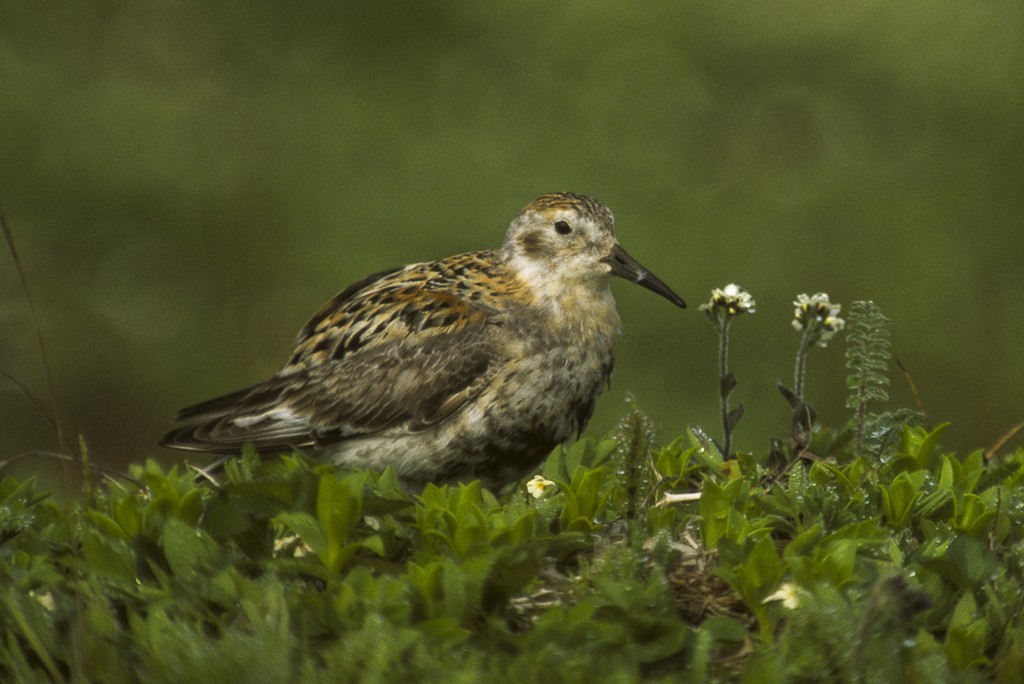Rock Sandpiper
A species of Calidris Scientific name : Calidris ptilocnemis Genus : Calidris
Rock Sandpiper, A species of Calidris
Botanical name: Calidris ptilocnemis
Genus: Calidris
 Photo By Francesco Veronesi , used under CC-BY-SA-2.0 /Cropped and compressed from original
Photo By Francesco Veronesi , used under CC-BY-SA-2.0 /Cropped and compressed from original Description
Adults have short yellow legs and a medium thin dark bill. The body is dark on top with a slight purplish gloss and mainly white underneath. The breast is smeared with grey and the rump is black. The Pribilof Islands subspecies of this bird shows a bold black belly patch. 
Size
23 cm (9 in)
Life Expectancy
7 years
Nest Placement
Ground
Feeding Habits
Rock Sandpiper primarily consume insects, aquatic invertebrates, and some plant material. During breeding, they forage in wet tundra for larvae and other insects, occasionally catching them mid-air. Nonbreeding season diet includes preying on invertebrates by probing sand, mud, or algae-covered rocks, and eating jellyfish and fish eggs.
Habitat
Rock Sandpiper primarily reside in coastal tundra habitats, flourishing in environments rich with lichens, mosses, dwarf shrubs, and diverse flora, below elevations of 1,000 feet. These birds adapt to a mix of wet and dry tundra zones, often near freshwater sources. In non-breeding seasons, they occupy tidal areas, including rocky shores and muddy flats, demonstrating versatility in coastal and inland freshwater habitats.
Nest Behavior
Before selecting a final site, rock Sandpiper males and females evaluate many potential locations over a week and may start several nests. The male builds the nest. Egg-laying and subsequent parental care patterns are not specified but are critical for the species' reproductive success.
Nest Characteristics
Rock Sandpiper typically nest on the ground or in elevated patches of mossy hummocks in dry tundra regions. The deep cup-shaped nest is constructed from local vegetation like willow leaves, sedges, grasses, and lichen. It averages 3.7 inches in diameter with a 2.9-inch wide interior cup and a depth of 1.8 inches.
Dite type
Aquatic invertebrate eater
Migration Overview
Birds migrate south to rocky ice-free Pacific coasts in winter. The subspecies leap frog each other for winter, with more northerly breeders passing south of more southerly breeders. It can form rather large wintering flocks. Rock Sandpipers which spend the non-breeding season in the Pacific Basin, Alaska, have to endure harsh conditions where they rely on high prey quality, especially of their primary prey - the bivalve Macoma balthica. 
General Info
Feeding Habits
Bird food type
Behavior
Rock Sandpiper exhibit distinctive behavior patterns, especially during the breeding season. In their Arctic and sub-Arctic habitats that often still bear snow, they congregate in flocks, foraging on available mudflats, rocky shores, or tundra. Males establish territories averaging 13 acres, engaging in vocal and aerial displays to attract mates and deter rivals. These displays include hovering, singing, wing-raising, and undulating flights. Males also engage in scraping displays on the ground, indicating potential nest sites to females. A female's acceptance is signaled by entering the chosen site. Rock Sandpiper demonstrate a unique connection with their environment, adapting their nesting to the delayed thaw and using notable visual and auditory signals in courtship.
Species Status
Not globally threatened.
Scientific Classification
Phylum
Chordates Class
Birds Order
Shorebirds Family
Sandpipers Genus
Calidris Species
Rock Sandpiper